SpaceX has set a new record for the heaviest payload launched on a Falcon 9 rocket as part of a routine Starlink satellite launch.
Simultaneously, the rocket responsible for setting that new record launched with a reusable booster that was last spotted clinging to life – engines heavily damaged – on the deck of a SpaceX drone ship eight months prior. At the time, it wasn’t clear if the Falcon 9 booster – theoretically capable of supporting at least 12-14 more launches – would be able to recover from the damage and fly again.
It’s now clear that the booster suffered no major invisible damage, ultimately allowing SpaceX to complete repairs and return the rocket to service at the cost of a lengthy delay.
According to spaceflight writer Alejandro Alcantarilla Romero, one additional cost – at minimum – was a full set of new Merlin 1D engines. Sometime shortly after Falcon 9 B1069’s flawless December 2021 launch and landing debut, a robotic helper known as Octagrabber most likely lost its grip on the booster while attempting to secure it. Likely already in high seas, the conditions prevented SpaceX workers from safely boarding the ship and manually securing the booster, which was then free to slide about its tilting deck.
Alternatively, it’s possible that Octagrabber successfully secured the booster but was then subjected to truly awful sea conditions. Designed to passively hold boosters to the deck with its sheer weight, even the tank-like robot wouldn’t be able to save a booster if a storm caught the drone ship off guard and the waves were high enough.
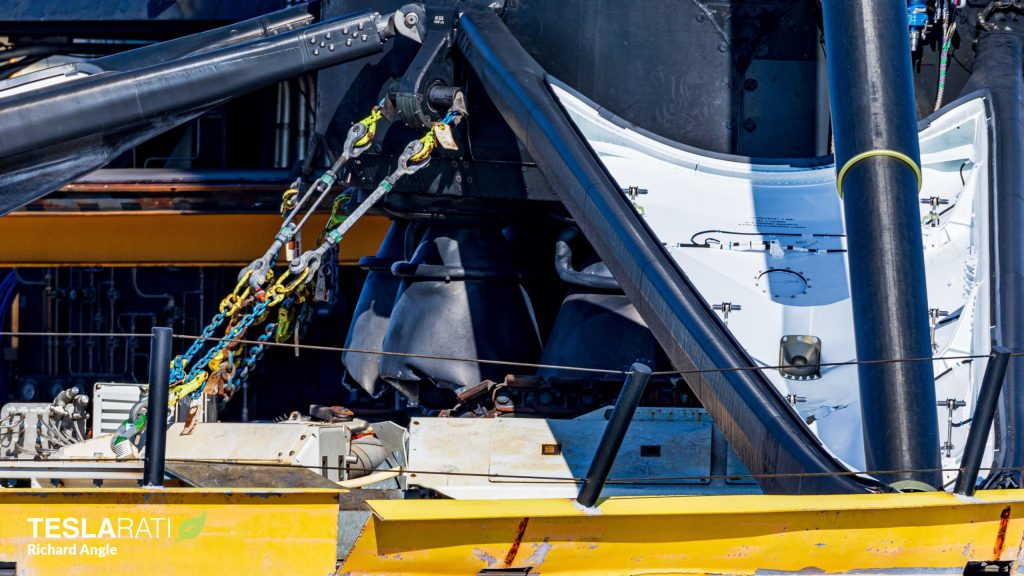
Either way, B1069 returned to port pressed against the lip of drone ship Just Read The Instructions’ (JRTI) deck, leaning hard to port. Worse, each of its nine fragile Merlin 1D engine nozzles had been crushed like tinfoil against Octagrabber, damaging them well beyond repair. While there’s a chance that SpaceX was or will be able to salvage the parts of B1069’s original M1D engines above their bell nozzles, it’s little surprise that the company had to fully replace those engines before the booster could fly again.
The damage B1069 suffered on its first launch makes it even more impressive that SpaceX attempted to break Falcon 9’s payload record with its return to flight, suggesting that the company was extremely confident in its repairs.
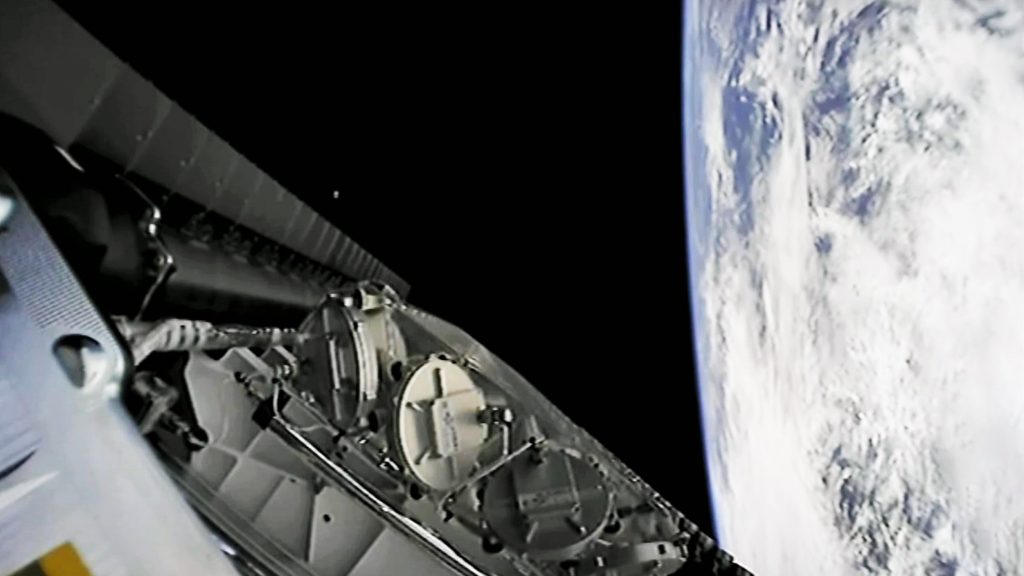
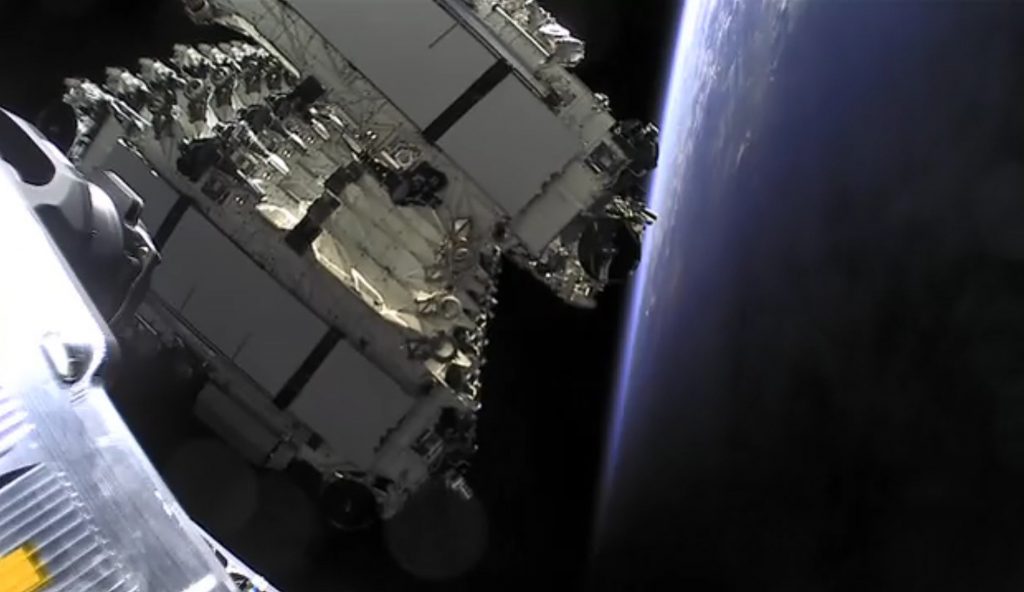
SpaceX confirmed that Falcon 9 broke the record with its launch of 54 Starlink V1.5 satellites at the end of its hosted webcast, revealing that the rocket launched 16.7 metric tons (~36,800 lb) to Low Earth Orbit (LEO). The last confirmed record – claimed by CEO Elon Musk – was 16.25 tons spread over 53 Starlink V1.5 satellites, which doesn’t entirely add up unless SpaceX added several kilograms to the mass of each satellite between March and August 2022.
Assuming that both numbers are comparable, a roughly 3% improvement is far from an earth-shaking or surprising step forward for SpaceX, a company, renowned for relentless iterative improvement. What is impressive, however, is that SpaceX pushed the envelope while Falcon 9 is both fast approaching its 150th consecutively successful launch and the only rocket currently certified to launch multiple NASA astronauts to the International Space Station. SpaceX’s fifth operational NASA astronaut launch (Crew-5) is scheduled as early as October 3rd. If SpaceX pushing the envelope on Starlink 4-23 had somehow caused the launch to fail, all Falcon 9 rockets would have likely been grounded for months, almost certainly delaying Crew-5 and throwing NASA’s ISS program into chaos.
Given how successful and reliable Falcon 9 already is, it would be hard to blame SpaceX if it decided to freeze the program and avoid additional changes, even if those changes could slightly improve the rocket’s performance. Instead, the company somehow manages to continue upgrading Falcon 9’s performance without obviously impacting its reliability or incurring the wrath of its strictest US government customers. Even Falcon landings, once considered a secondary objective that could be allowed to fail, haven’t suffered. Starlink 4-23 marked SpaceX’s 64th consecutively successful booster landing.
Up next, SpaceX is scheduled to launch Starlink 3-4 no earlier than (NET) August 31st, Starlink 4-20 NET September 4th, and Starlink 4-2 NET September 7th.

Investor's Corner
Tesla price target boost from its biggest bear is 95% below its current level

Tesla stock (NASDAQ: TSLA) just got a price target boost from its biggest bear, Gordon Johnson of GLJ Research, who raised his expected trading level to one that is 95 percent lower than its current trading level.
Johnson pushed his Tesla price target from $19.05 to $25.28 on Wednesday, while maintaining the ‘Sell’ rating that has been present on the stock for a long time. GLJ has largely been recognized as the biggest skeptic of Elon Musk’s company, being particularly critical of the automotive side of things.
Tesla has routinely been called out by Johnson for negative delivery growth, what he calls “weakening demand,” and price cuts that have occurred in past years, all pointing to them as desperate measures to sell its cars.
Johnson has also said that Tesla is extremely overvalued and is too reliant on regulatory credits for profitability. Other analysts on the bullish side recognize Tesla as a company that is bigger than just its automotive side.
Many believe it is a leader in autonomous driving, like Dan Ives of Wedbush, who believes Tesla will have a widely successful 2026, especially if it can come through on its targets and schedules for Robotaxi and Cybercab.
Justifying the price target this week, Johnson said that the revised valuation is based on “reality rather than narrative.” Tesla has been noted by other analysts and financial experts as a stock that trades on narrative, something Johnson obviously disagrees with.
Dan Nathan, a notorious skeptic of the stock, turned bullish late last year, recognizing the company’s shares trade on “technicals and sentiment.” He said, “From a trading perspective, it looks very interesting.”
Tesla bear turns bullish for two reasons as stock continues boost
Johnson has remained very consistent with this sentiment regarding Tesla and his beliefs regarding its true valuation, and has never shied away from putting his true thoughts out there.
Tesla shares closed at $431.40 today, about 95 percent above where Johnson’s new price target lies.
News
I subscribed to Tesla Full Self-Driving after four free months: here’s why
It has been incredibly valuable to me, and that is what my main factor was in considering whether to subscribe or not. It has made driving much less stressful and much more enjoyable.
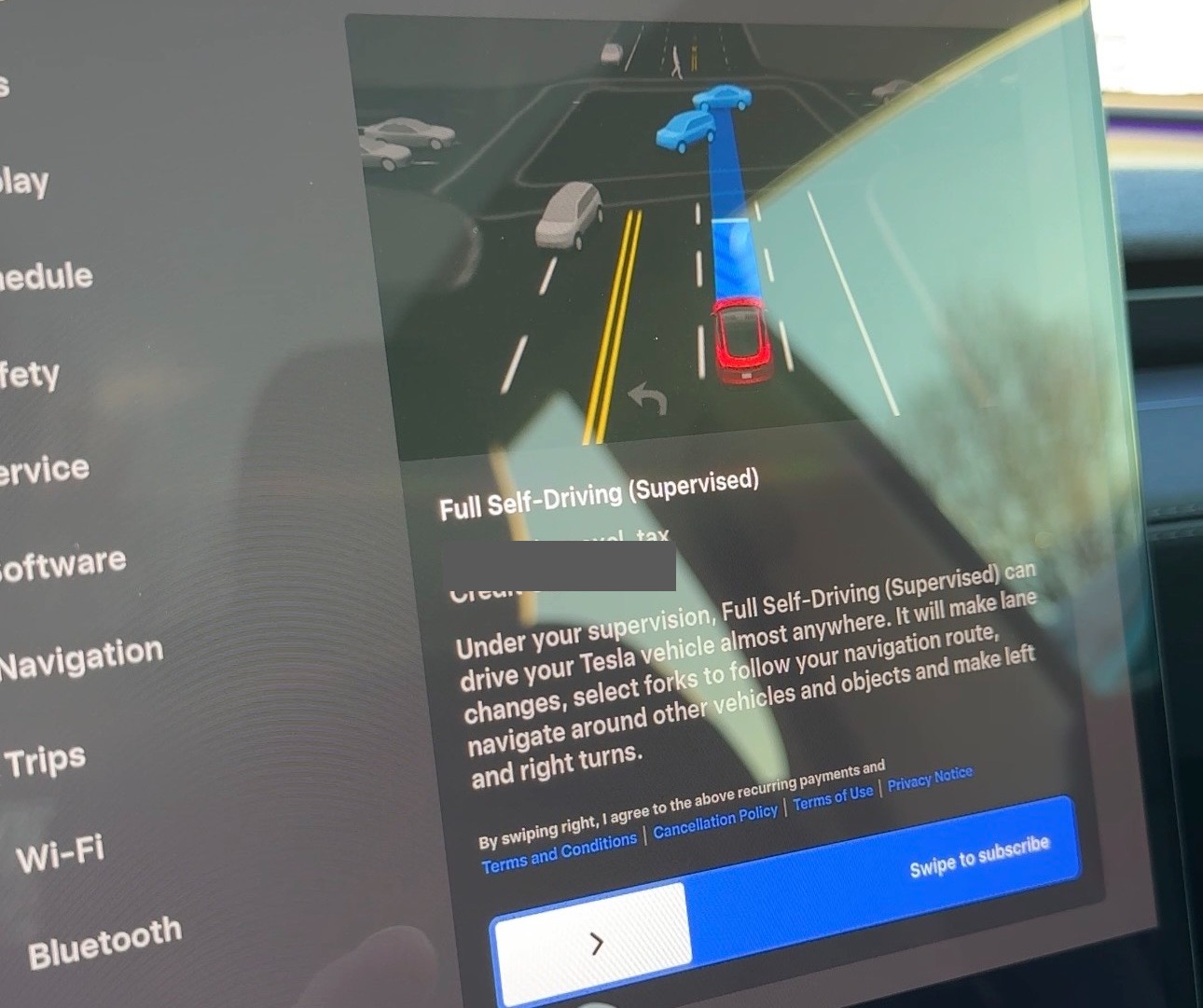
I have been lucky enough to experience Tesla Full Self-Driving for the entire duration of my ownership experience for free — for four months, I have not had to pay for what I feel is the best semi-autonomous driving suite on the market.
Today, my free trial finally ran out, and I had two choices: I could go without it for a period until I felt like I absolutely needed it, or I could subscribe to it, pay $99 per month, and continue to experience the future of passenger transportation.
I chose the latter, here’s why.
Tesla Full Self-Driving Takes the Stress Out of Driving
There are a handful of driving situations that I don’t really enjoy, and I think we all have certain situations that we would just rather not encounter. This is not to say that I won’t ever experience them as someone who has driven a car for 15 years (it feels weird saying that).
I don’t love to drive in cities; I really don’t like driving on I-695 on my way to Baltimore, and I truly hate parallel parking. All three things I can do and have done, all three within the past few weeks, too.
It takes all the stress out of city driving pic.twitter.com/q0SPPrH4HU
— TESLARATI (@Teslarati) December 4, 2025
However, if I can avoid them, I will, and Tesla Full Self-Driving does that for me.
Tesla Full Self-Driving Eliminates the Monotony
I drive to my alma mater, Penn State University, frequently in the Winter as I am a season ticket holder to Wrestling and have been for 16 years now.
The drive to State College is over two hours and over 100 miles in total, and the vast majority of it is boring as I travel on Rt 322, which is straight, and there is a lot of nature to look at on the way.
I am willing to let the car drive me on that ride, especially considering it is usually very low traffic, and the vast majority of it is spent on the highway.
The drive, along with several others, is simply a boring ride, where I’d much rather be looking out the windshield and windows at the mountains. I still pay attention, but having the car perform the turns and speed control makes the drive more enjoyable.
Tesla Full Self-Driving Makes Navigating Easier
Other than the local routes that I routinely travel and know like the back of my hand, I’ve really enjoyed Full Self-Driving’s ability to get me to places — specifically new ones — without me having to constantly check back at the Navigation.
Admittedly, I’ve had some qualms with the Nav, especially with some routing and the lack of ability to choose a specific route after starting a drive. For example, it takes a very interesting route to my local Supercharger, one that nobody local to my area would consider.
But there are many times I will go to a new palce and I’m not exactly sure where to go or how to get there. The Navigation, of course, helps with that. However, it is really a luxury to have my car do it for me.
To Conclude
There was no doubt in my mind that when my Full Self-Driving trial was up, I’d be subscribing. It was really a no-brainer. I am more than aware that Full Self-Driving is far from perfect, but it is, without any doubt, the best thing about my Tesla, to me.
It has been incredibly valuable to me, and that is what my main factor was in considering whether to subscribe or not. It has made driving much less stressful and much more enjoyable.
🚨 How I’ve gotten Tesla Full Self-Driving for free…until now
Watch me subscribe to Tesla FSD! https://t.co/bjK7EEOptR pic.twitter.com/cs5CmN5PdJ
— TESLARATI (@Teslarati) January 7, 2026
News
Tesla Diner becomes latest target of gloom and doom narrative
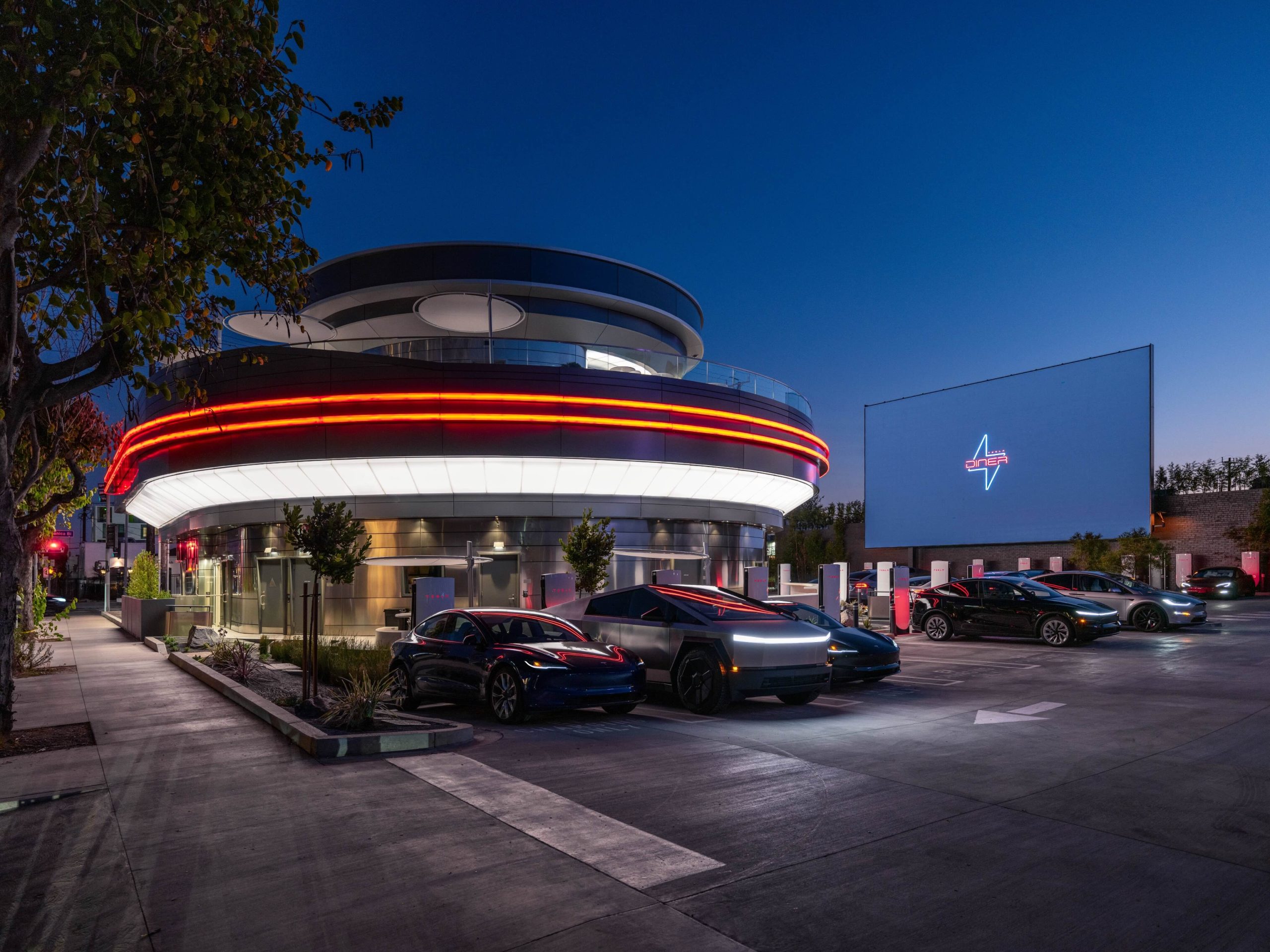
The Tesla Diner has been subject to many points of criticism since its launch in mid-2025, and skeptics and disbelievers claim the company’s latest novel concept is on its way down, but there’s a lot of evidence to state that is not the case.
The piece cites anecdotal evidence like empty parking lots, more staff than customers during a December visit, removed novelty items, like Optimus robot popcorn service and certain menu items, the departure of celebrity chef Eric Greenspan in November 2025, slow service, high prices, and a shift in recent Google/Yelp reviews toward disappointment.
The piece frames this as part of broader Tesla struggles, including sales figures and Elon Musk’s polarizing image, calling it a failed branding exercise rather than a sustainable restaurant.
This narrative is overstated and sensationalized, and is a good representation of coverage on Tesla by today’s media.
Novelty Fade is Normal, Not Failure
Any hyped launch, especially a unique Tesla-branded destination blending dining, Supercharging, and a drive-in theater, naturally sees initial crowds taper off after the “Instagram effect” wears down.
Tesla makes major change at Supercharger Diner amid epic demand
This is common for experiential spots in Los Angeles, especially pop-up attractions or celebrity-backed venues. The article admits early success with massive lines and social media buzz, but treats the return to normal operations as “dying down.”
In reality, this stabilization is a healthy sign of transitioning from hype-driven traffic to steady patronage.
Actual Performance Metrics Contradict “Ghost Town” Claims
- In Q4 2025, the Diner generated over $1 million in revenue, exceeding the average McDonald’s location
- It sold over 30,000 burgers and 83,000 fries in that quarter alone. These figures indicate a strong ongoing business, especially for a single-location prototype focused on enhancing Supercharger experiences rather than competing as a mass-market chain
It’s not a ghost town lol. The @Tesla Diner still had over 30,000 burger orders and 83,000 fries orders in Q4. The diner generated over $1M in revenue in Q4, a $4M annual run rate, which is more than the average McDonald’s…. pic.twitter.com/XvAGLUqxej
— Sawyer Merritt (@SawyerMerritt) January 4, 2026
Conflicting On-the-Ground Reports
While the article, and other similar pieces, describe a half-full parking lot and sparse customers during specific off-peak visits, other recent accounts push back:
- A January 2026 X post noted 50 of 80 Supercharger stalls were busy at 11 a.m., calling it “the busiest diner in Hollywood by close to an order of magnitude
TESLA DINER 🍔
Frantic!!!
Crazy busy. pic.twitter.com/wMbmr8SFFn
— Rich & Sharon (@HullTeslaModel3) January 4, 2026
- Reddit discussions around the same time describe it as not empty when locals drive by regularly, with some calling the empty narrative “disingenuous anti-Tesla slop.”
When we visited it last week it was packed. We had to wait to enter, get a table and go to the restroom. We were lucky to find a spot to charge.
— Rani G (@ranig) January 4, 2026
Bottom Line
The Tesla Diner, admittedly, is not the nonstop circus it was at launch–that was never sustainable or intended. But, it’s far from “dying” or an “empty pit stop.”
It functions as a successful prototype: boosting Supercharger usage, generating solid revenue, and serving as a branded amenity in the high-traffic EV market of Los Angeles.










